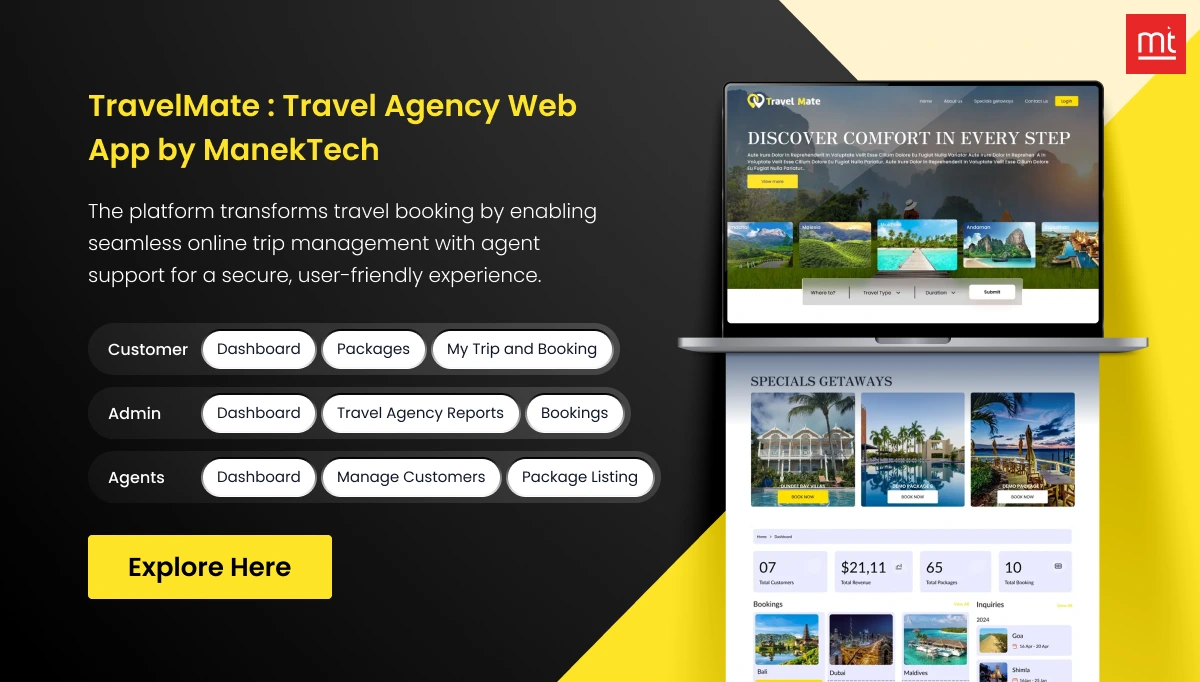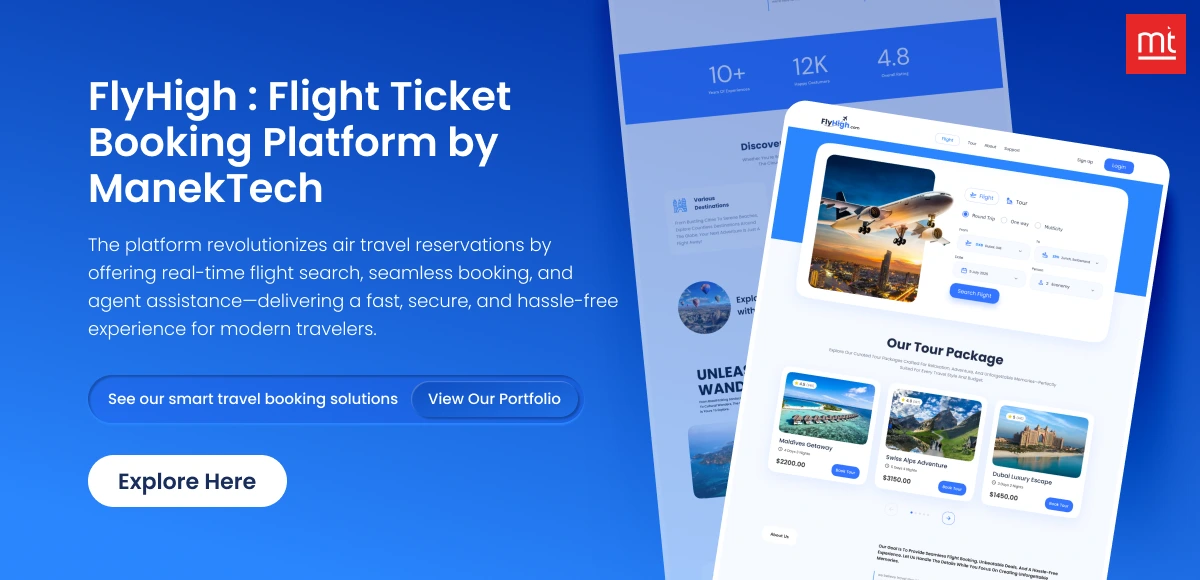Get Free Trial Week Developer Access, Try Before You Hire. Click Here to Claim Now
Key Takeaway
If you are thinking about how to develop a Flight Booking Website like Expedia, then you must have so many doubts related to features, technology, timelines, and costs. This blog will walk you through every step to understand what goes into building a powerful travel app, from real-time booking engines to AI-driven personalization. You will also explore how these flight booking websites work, why investing in one makes business sense, and real-world case studies like Skyscanner and Hopper to develop the best flight booking website according to modern user expectations.
Introduction:
Flight booking websites have become an essential necessity in today’s travel landscape. Because it allows you to browse, compare, and book flights instantly from home’s comfort. We can’t imagine our life without a flight booking website. If we look at market statistics, the U.S. flight booking app market has grown significantly in the last few years. The online travel industry was valued at $566.74 billion in 2024 and is expected to grow up to $1.37 trillion by 2033. Over 72% of US travellers choose to book flights online. Research also says that 48% of people feel comfortable using AI to organize their travel plans. 41% of people in the U.S. prefer using online travel sites to book vacations, while 29% depend on travel agents.
There are already a lot of flight booking websites and apps out there such as Skyscanner, Kayak, Hopper, MakeMyTrip, Cleartrip, and Rehlat. Most of these platforms focus mainly on flight searches and basic booking features. But very few offer features like Expedia i.e book flights, hotels, car rentals, and vacation packages.
Expedia is an all-in-one travel booking platform which holds over 19.3% markshet share in the U.S market. It earns commission through each booking made through it and from ads, special listings, and travel deals promoted on the site.
In this article, you will learn how to build a flight booking website like Expedia that delivers performance and profit.
How Does an Airline Reservation Website like Expedia Work?
An airline reservation website works by connecting travelers to real-time flight data using systems like Global Distribution Systems (GDS) or direct APIs from airlines. These systems show flight times, prices, and seat availability instantly.
When you pick a flight, the site calculates the final price, lets you enter passenger details, and processes payment securely. After booking, it issues an e-ticket and sends a confirmation.
Expedia also works a bit similarly. It works as a travel marketplace. Here, when you search for flights for suitable dates and destinations, Expedia fetches real-time data from different airlines using GDS and CRS. And it will show different airlines and their prices to you to compare prices, times, and options in one place. You can choose a flight or a travel service and simply pay for the flight fare. You get a booking confirmation, and the provider reserves your ticket or service.
Why Should You Invest in Flight Booking Website Development like Expedia?
Developing a Flight Booking Website like Expedia will provide a lot of revenue opportunities and global reach. Expedia has a great history of 46 million users in 2024. In fact, it is the leading travel website used by the US population and manages over 200 different travel-related sites.
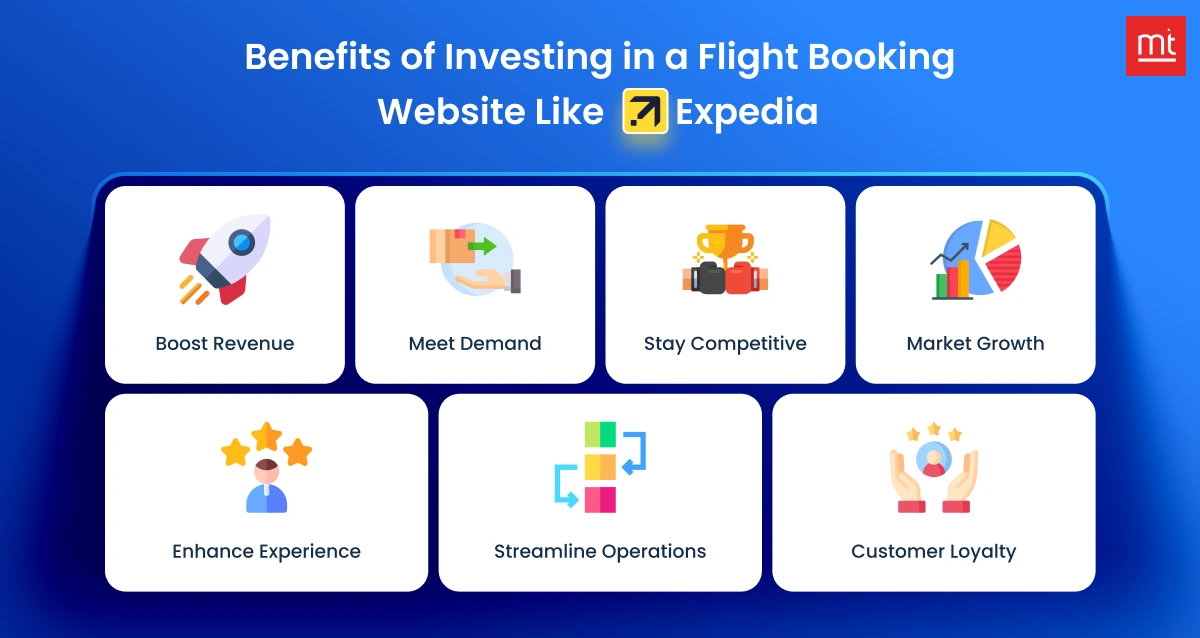
1. Boost Revenue
Making a flight booking website will open multiple source of revenue streams. You can earn through commissions from airlines and hotels, service fees, ads, and selling extras like insurance or tours. Plus, if you include other facilities or features, you can generate a good, steady income with growing travel activity and by offering good deals to users.
2. Meet Demand
These days, people want to plan and book their trips online, often from their phones. This has been the growing scenario after the COVID pandemic. If you include AI and personalized recommendations, and real-time notifications in your flight booking website, it meets the overall demand of users.
3. Stay Competitive
The travel industry is highly competitive, and digital transformation is moving fast. If you don’t offer extraordinary features with online booking, you will stay behind. An AI-powered flight booking website helps you compete with big flight booking websites by offering features travelers expect, like flexible search, real-time updates, and quick booking.
4. Market Growth
The online travel market is constantly growing every year as travelers are moving digital. With time, there are infinite possibilities, and so building a flight booking platform will help you to stay at the top.
5. Enhance Experience
Today’s travelers want fast searches, personalized suggestions, and easy checkouts. You must include these basic things in a flight booking site, and some AI features like price alerts and trip recommendations. In short, customers should be able to find what is important for their travel plan.
6. Streamline Operations
A booking website helps customers by automating tasks like confirming bookings, sending tickets, handling cancellations, and tracking payments. This saves a lot of time, reduces errors as compared to traditional flight bookings through agents.
7. Customer Loyalty
You can build a loyal customer base and credibility by offering rewards like loyalty points, member-only deals, and personalized offers. When your website has the right features, users will repeatedly use it and build a long-term relationship.
What Technologies Are Used to Build Flight Booking Websites?
Flight booking websites require a variety of technologies to operate securely. It requires backend languages like Java, Python, or Node.js, while APIs like Amadeus and Sabre provide real-time flight data. Plus, it also needs payment gateways like Stripe, modern front-end tools like React, databases like MySQL, and cloud hosting to manage bookings, user info, and secure payments.
Go through the table below to get more clarity.
Category | Tools & Technologies | Purpose |
Frontend (UI/UX) | HTML5, CSS3, JavaScript, React.js, Vue.js, Tailwind CSS | To build a responsive, user-friendly interface |
Backend (Server-side) | Node.js, Python (Django), PHP (Laravel), Ruby on Rails, Java (Spring Boot) | To handle business logic, APIs, and server operations |
Database | PostgreSQL, MySQL, MongoDB | Store user data, bookings, payments, and travel records |
Flight Data Integration | Amadeus, Sabre, Travelport (GDS) Skyscanner API, Duffel, Kiwi API (Non-GDS) | Access real-time flight schedules, pricing, and availability |
Payment Gateway | Stripe, Razorpay, PayPal, Braintree | Process secure payments and refunds |
Authentication | Firebase Auth, Auth0, OAuth 2.0 | Secure user login and identity management |
Search & Filtering | Elasticsearch, Algolia | Deliver fast and accurate flight and hotel search results |
Cloud & Hosting | AWS, Google Cloud Platform, Microsoft Azure | Host, scale, and manage the application |
DevOps & CI/CD | Docker, Jenkins, GitHub Actions, Kubernetes | Automate testing, deployment, and version control |
AI & Personalization | TensorFlow, Amazon Personalize, OpenAI API | Power recommendations, chatbots, and dynamic pricing |
Notifications | Firebase Cloud Messaging, OneSignal, Twilio | Send real-time alerts (price drops, booking updates, etc.) |
Maps & Location | Google Maps API, Mapbox | Show nearby airports, destinations, and directions |
Analytics & Monitoring | Google Analytics, Mixpanel, Sentry, New Relic | Track user behavior, app performance, and error logs |
CMS for Content | Strapi, WordPress (Headless), Contentful | To manage content like blogs, guides, offers, and FAQs |
Security Tools | SSL/TLS, OWASP ZAP, Cloudflare | Ensure data protection, threat prevention, and secure access |
What Are the Key Features of an AI-Powered Flight Booking Website?
Key features of an AI flight booking website include: real-time flight tracking, personalized suggestions, flexible search filters, smart pricing, chatbots, and loyalty integration. Let's understand all the important features one by one.
Usually, flight booking websites can be divided into two parts: customer and admin. Both have different roles and features.
Key Customer Features of a Flight Booking Website:
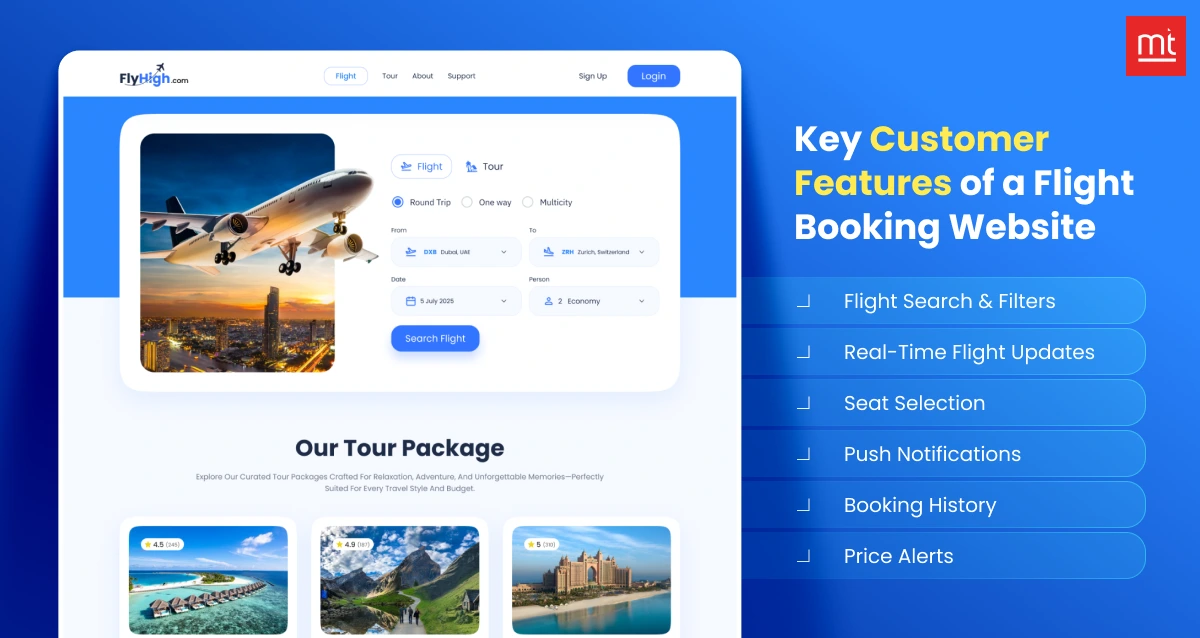
Flight Search & Filters: Search filters allow users to search flights by date, destination, price, airline, or duration.
Real-Time Flight Updates: It shows live flight status if there are any delays, cancellations, or gate changes, to keep travelers informed about the changes.
Seat Selection: Customers can choose their preferred seat (window, aisle, etc.) during booking.
Push Notifications: Send timely alerts about booking status, flight reminders, or changes so users don't need to look into the website again and again.
Booking History: This shows past trips and bookings for easy rebooking of trips and track expenses.
Price Alerts: This is for providing the best deals to users. It will notify users when the flight prices drop or any seasonal offers are running.
Key Admin Panel Features of a Flight Booking Website:
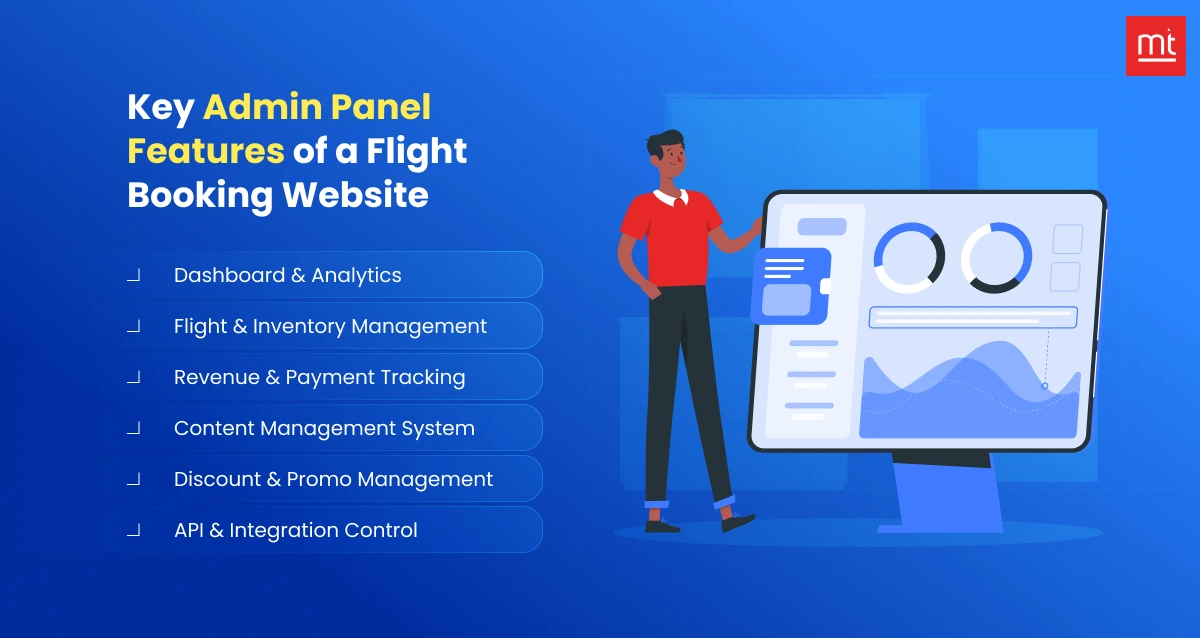
Dashboard & Analytics: Admins can see a visual overview of bookings, revenue, and user behavior for future improvement.
Flight & Inventory Management: Admins can add, update, or remove flight details and availability to ensure flight details are accurate.
Revenue & Payment Tracking: Admin can track earnings, commissions, and payment statuses in real time through the website.
Content Management System: Admins can update the website content, like banners, travel guides, or FAQs.
Discount & Promo Management: for marketing purposes or peak season, admins can also create coupons or offers to attract more users.
API & Integration Control: For third-party tools like GDS, payment gateways, and flight APIs to maintain a smooth booking flow.
Key Advance Features of a Flight Booking Website:
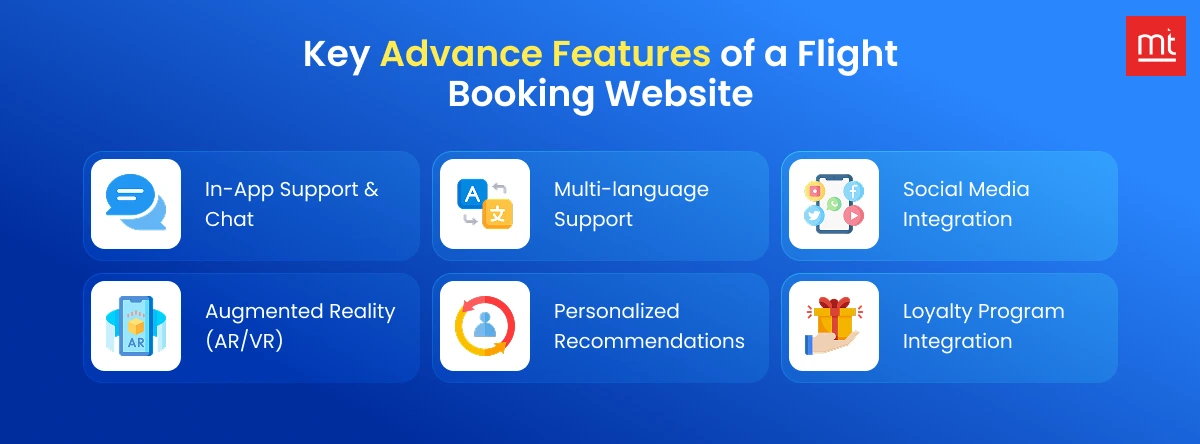
In-App Support & Chat: This helps users to chat with the assistant to solve their concerns regarding booking, payment, and more.
Multi-language Support: As the flight booking website is used by global users, it must have multi-language options so non-English speakers can use the website for booking easily.
Social Media Integration: Users can log in with social media accounts or share their travel plans with friends
Augmented Reality (AR/VR): Users can take virtual tours of airport terminals, hotel rooms, or airplane cabins before booking
Personalized Recommendations: Based on the user’s past searches or trips, it will suggest flights, destinations, and offers.
Loyalty Program Integration: Repeated users get reward points and loyalty bonus, which can be used as discounts on their flight bookings.
How to Develop a Flight Booking Website like Expedia? Step-by-Step Guide
If you don't know how to create a custom airline reservation website, you have to begin with market research, define must-have features, choose the right tech stack, and design a user-friendly interface. Then, move on to development, integrate global flight APIs, ensure legal compliance, and perform thorough QA testing before launch. If you want to know more in details, check out our steps, which guide you through the process of building a travel booking platform like Expedia.
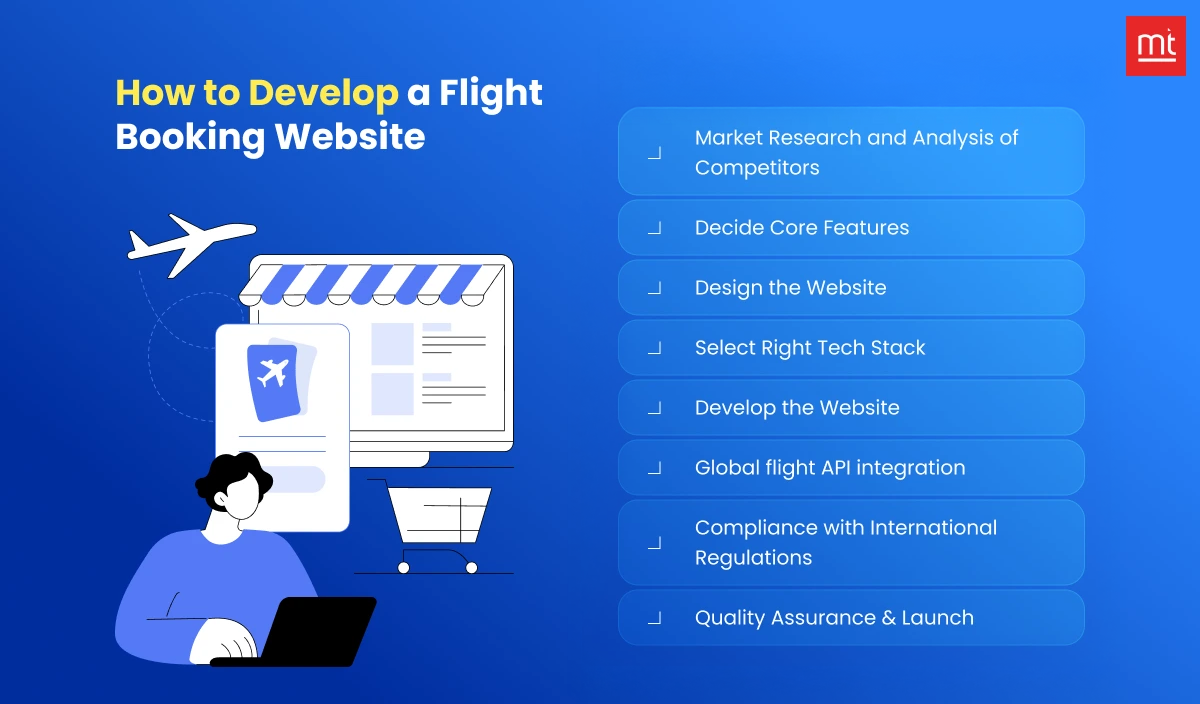
1. Market Research and Analysis of Competitors
There are already big names like Expedia, Skyscanner, and many more in the travel industry. Study these top competitors and know what features they offer, what users love, and what’s missing. Know your target audience, and do solid research from top to bottom. This will help you identify gaps in the market and decide your unique selling points.
If you want to make the most out of your research and analysis, clear these questions on the top priority. Knowing this will help you to finalize the USPs that other flight booking platforms don't have.
- Who are my leading competitors in the online flight booking industry?
- What are the strategies to attract and retain users on flight booking websites?
- What are your competitors' current gaps or limitations?
2. Decide Core Features
Now you know your target audience, competitors, and their limitations, so the next thing is to decide the core features of the flight booking website. Common features of flight booking are search, booking, notification, offers, etc., but think about how you can make your flight booking platform different from others like Expedia.
Expedia offers extraordinary features like car rentals, hotels, trip itinerary planning, vacation packages, vacation packages, and more.
If you want to cut your website development costs, then ask yourself these questions to finalize only the important and unique features in the website.
- What are the features of Skyscanner, Google Flights, and Kayak?
- Why is real-time fare comparison and availability tracking important for users?
- Should I add multi-city and flexible date search options to my flight booking platform?
3. Design the Website
Great design is the key to retaining users. You might need to hire a UI UX designer who has previously designed a flight booking website or app. Experienced designers know what an easy and quick flight booking prototype looks like hence they can create a clean, intuitive layout for search, booking, and checkout.
Before you hire a UI/UX designer or partner with any web development company, ask them these questions.
- What are the necessary design elements required for a great user experience on a flight booking website?
- How will you make sure of a mobile and desktop booking experience?
- How does navigation play an important role in increasing conversions?
4. Select the Right Tech Stack
To choose the right technology, first, you must decide what kind of flight booking website you want to create. If you are a small travel agency and just need an MVP, use Node.js with Express as a backend. React.js or Vue.js can be the best choice for the front-end.
If you run a medium-sized travel company, Python with Django is suitable as a backend and Angular as a front-end. For developing a platform like Expedia, choose Java with Spring Boot as a backend, and React.js as a front-end. Other than this, if you wish to develop a no-code platform, you can also take help from a WordPress development company. WordPress offers really good travel themes to create a flight booking website.
Your tech stack directly affects how much your website costs and how long it takes to build. As flight booking websites continuously evolve, ask these questions earlier.
- What is the best tech stack for building a scalable flight booking website?
- Should you choose a monolithic or microservices architecture for travel platforms?
- How do third-party APIs like GDS and flight aggregators impact tech stack decisions?
5. Develop the Website
Once you finalize the back-end, front-end framework, API, and all technical things, start the development process. Hire an experienced website development company to simplify your development process. This will also help you to scale in the future when there are the latest updates.
Before hiring any company, discuss these questions with them.
- How long does it take to build a flight booking site?
- What are the development challenges in integrating real-time flight data?
- Can you build the booking engine from scratch, or prefer using third-party APIs?
6. Global Flight API Integration
Now, it's time to connect the website with the flight API. Connect your platform to Global Distribution Systems (GDS) like Amadeus, Sabre, or Travelport using APIs. These APIs help to get live flight data, availability, pricing, and booking systems across airlines.
Choosing the wrong API can mess up the website functionality. This is why ask the questions below to avoid integration challenges and ensure a good user experience.
- Which tools can you rely on to get up-to-date flight options and prices?
- What makes these big travel platforms different is how easy they are to use and how much they charge.
- What are the important things to check (like support, features, and fees) before you choose an API for your website?
7. Compliance with International Regulations
Your flight booking website should follow global data protection and aviation regulations. It should also comply with GDPR for user data, PCI-DSS for secure payments, and airline industry standards. You must show clear cancellation and refund policies on your website; this will help you avoid legal issues.
If you want to implement security and legal things correctly, make sure to learn these things first.
- What international regulations must a flight booking website comply with?
- How does GDPR, PCI-DSS, and IATA compliance affect flight booking platforms?
- What are the legal risks of handling user data and payments globally?
8. Quality Assurance & Launch
Before launching your flight booking website, test it automatically and manually. If you have hired a reputable website development company, the team of QA and testers will handle this job well. They will test design, speed, booking flow, payments, and APIs to catch bugs, performance issues, or UI problems.
So that you can launch the website with confidence.
You must know what tests to run, how to ensure cross-device performance, and what launch strategies to follow—consider questions below to avoid costly errors and build user trust from day one.
- What key tests should be conducted before launching a flight booking website?
- How can you ensure a smooth user experience across devices and browsers?
- What are the best practices for launching a flight booking platform successfully?
How Can You Maximize Revenue Opportunities with Your Flight Booking Website?
Your flight booking website can turn into a strong business if you know how to maximize the revenue opportunities. Here are the proven ways how you can monetize your flight booking website.
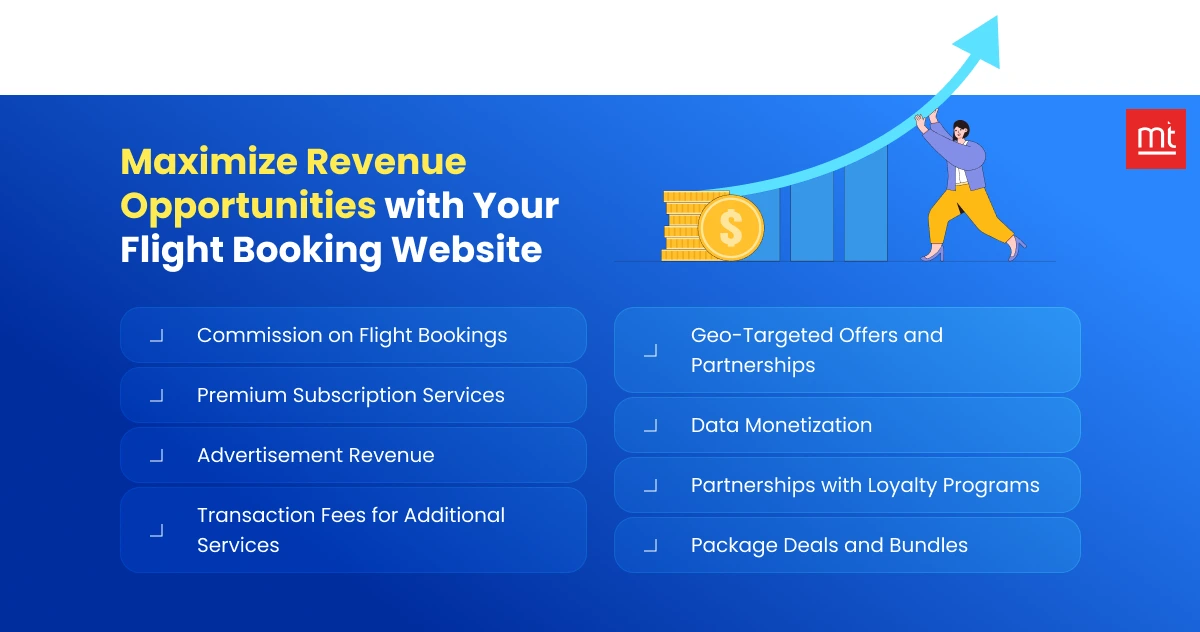
Commission on Flight Bookings: You can earn a suitable percentage of commissions from every flight booked through your website. More bookings mean more commissions.
Premium Subscription Services: You can also offer extra benefits to users like early access to flight deals or no service charges, as a monthly or yearly subscription.
Advertisement Revenue: You can partner with a hotel, luggage brand, or any insurance company to show their ads. Whenever any user clicks or buys a product from these ads, you earn commission.
Transaction Fees for Additional Services: You can keep a small extra fee for users who want emergency boarding, seat upgrades, or travel insurance.
Geo-Targeted Offers and Partnerships: You can show the best hotel deals according to the user's location by partnering with multiple hotels.
Data Monetization: You can use users’ data safely and legally to provide the information to travel companies by charging a minimal fee.
Partnerships with Loyalty Programs: You can partner with airlines and hotels to offer points on the first booking.
Package Deals and Bundles: You can create packages like flight + hotel + car rental combos at discounted prices to attract more users. This will make travellers' planning easier.
How Much Does It Cost to Develop an AI Flight Booking Website?
The cost to develop an AI flight booking website can usually range from $30,000 to $100,000 or even more, depending on its features, complexity, technology stack selection, location of developers, and much more.
Look at the table below to see a detailed breakdown of costs by region, features, and technology.
Region | Estimated cost | What you get |
UAE | $60-$65 | Mid-scale product with payment localization and Arabic support |
Wester Europe | $80-$90 | Enterprise-grade system, multilingual support, premium UX |
Eastern Europe | $50-$55 | Full-featured site with high-quality UX and secure payments |
US | $95-$100 | Highly scalable AI-based solution with premium features and fast support |
Australia | $70-$90 | An enterprise-level flight booking website with advanced functionalities and basic features. |
Asia | $25-$40 | Lightweight booking site, solid UI, local API support |
Cost by Features and Functionality
Features | Estimated Cost | Priority |
Flight Search & Filters | $5,000 – $10,000 | Must-Have (MVP) |
Real-Time Flight Updates | $3,000 – $6,000 | Must-Have (MVP) |
Seat Selection System | $2,500 – $5,000 | Must-Have (MVP) |
Booking & Payment Integration | $4,000 – $8,000 | Must-Have (MVP) |
User Account & Booking History | $3,000 – $5,000 | Essential |
Price Alerts and notifications | $2,000 – $4,000 | Nice-to-Have |
Admin Dashboard & Analytics | $4,000 – $7,000 | Must-Have (MVP) |
Inventory Management | $3,000 – $6,000 | Essential |
Discount & Promo Management | $2,500 – $4,500 | Nice-to-Have |
Global Flight API Integration | $6,000 – $12,000 | Must have |
CMS for Content Management | $3,000 – $5,000 | Nice-to-Have |
Multi-language Support | $2,000 – $4,000 | Optional |
In-App Chat Support | $3,500 – $6,000 | Advanced |
Loyalty Program Integration | $4,000 – $8,000 | Advanced |
Technology Stack and Cost Implications
Tech stack | Examples | Estimated Cost (USD) |
Backend Logic | Node.js, Ruby on Rails | $20,000 – $50,000 |
Frontend Interface | React.js, Flutter, Vue.js | Ranges from $15,000 – $40,000 or more |
Database Architecture | MongoDB, PostgreSQL, MySQL | $5,000 – $15,000 |
API & System Integration | RESTful APIs, GDS (Amadeus, Sabre) | $10,000 – $30,000 |
Cloud Infrastructure | AWS, Azure, Google Cloud | $5,000 – $20,000 |
What Are Some Real-Time Case Studies of High-Impact Flight Booking Website Development?
If you're planning to build a flight booking website, these real-world case studies will inspire you. It will help you learn how companies created high-performing platforms with smart features, smooth user flows, and strong backends. Plus, what made them stand out in the market.
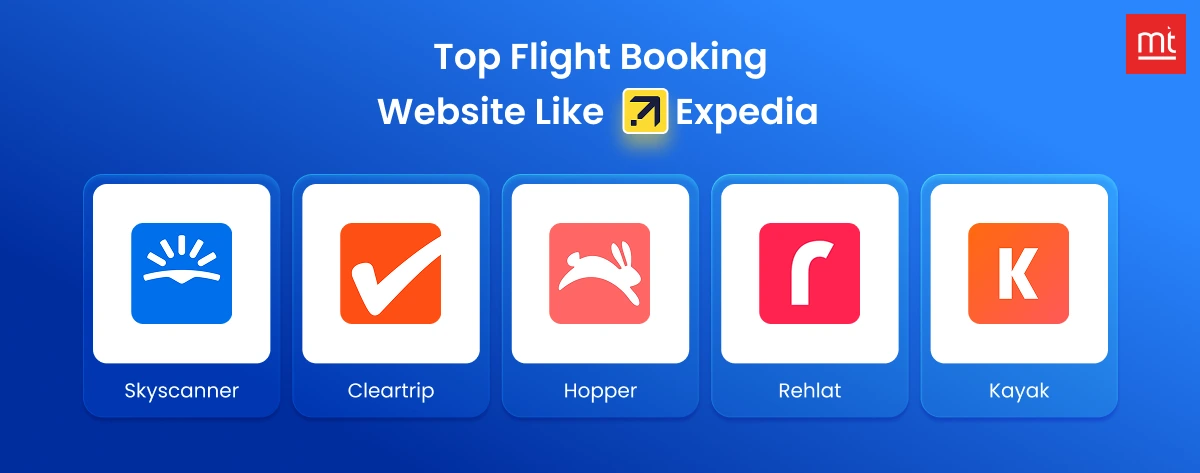
Skyscanner (UK/Global)
Cleartrip (Middle East/India)
Hopper (US)
Rehlat (Middle East)
Kayak (US/Global)
How Can ManekTech Help You Build Custom Flight Booking Websites for Travel Businesses?
Being an experienced website development company, we hold 14 plus years of experience in serving clients globally for app and website needs. Having a diverse client list in travel agencies, online booking portals, and hospitality brands, our team has a hands-on experience and knowledge in flight booking website and travel app development. Whether you want a simple flight booking website with limited functionality or a full enterprise-level website, we can customize the website design and functionalities to meet your target audience and business ROI goals.
ManekTech Case Study:
1. TravelMate: Travel Agency Web App
2. Flight Ticket Booking Platform
Conclusion
Now you might get whole idea on how to develop a flight booking website like Expedia. With lots of other supporting features, and quick bookings.Expedia has been one of the best websites to book flights for thousands of people across globe. Hence if you want to make better than that, it needs detailed research, the right strategy, and organized execution to make your flight booking website stand out strongly. Prioritize user experience, real-time data, and mobile responsiveness. Choose technologies based on your business goals, budget, and scalability needs to get long-term value.
If you need a globally scalable flight booking solution? Book a free consultation call with Manektech to know the cost to develop a flight booking website like Expedia and learn more.

FAQs Related to AI Flight Booking Website
Q 1. What Are the Business Models for Flight Booking Websites?
Ans: Flight booking websites earn through agencies, merchants, and advertising. This works by partnering with airlines or hotels by sponsoring their products on websites, or by adding commissions.
Q 2. What Are the Challenges in Launching a Flight Booking Platform in the U.S.?
Ans: Evolving nature, cybersecurity threats, complex partnerships, regulatory compliance, and high competition are some of the challenges that occur while launching the flight booking website in the U.S.
Q 3. How to Differentiate a Flight Booking Website in a Competitive Market?
Ans: Focus on better user experience, price alerts, personalized recommendations, and unique travel tools. Plus, give loyalty rewards for first-time users and repeat users.
Q 4. What Are the Top Use Cases for Flight Booking Platforms in the U.S.?
Ans: Below are some of the top use cases of flight booking platforms:
- Finding the Cheapest Flights: Users compare prices across airlines to get the best deal.
- Booking Last-Minute Travel: useful for business travelers or emergencies.
- Multi-city Trip Planning: Useful to book multiple stops.
- Corporate Travel Management: Companies can book and manage flights for employees.
- Vacation package: Flights + hotels + cars booked together.
Q 5. How to Monetize Your Skyscanner Clone Website?
Ans: You can earn through affiliate commissions, sponsored placements, travel insurance upsells, or premium features.
Q 6. How Long Does It Take to Build a Flight Booking Website Like Skyscanner?
Ans: It takes 4 to 9 months, depending on your features, team size, and integrations. If you use pre-built APIs, it can speedup the development.
Q 7. What Are the Benefits of Developing a Custom Flight Booking Website?
Ans: Developing a custom flight booking website will give you more control over how it looks and works. You can add special features just for your business, make it match your brand, and easily update it as you grow.
Q 8. What Factors Affect the Development Cost of a Flight Booking Website?
Ans: Features, region of the development team, design complexity, API costs, and tech stack affect the cost of a flight booking website.
Q 9. Can I Integrate a Flight Booking Engine into an Existing Travel Website?
Ans: Yes, you just need the right API and back-end support to integrate a flight booking engine to your existing travel website.
Q 10. How to Create a Successful Alternative to Expedia?
Ans: Find a specific niche, offer a smooth and smart booking experience, and build strong airline/API partnerships.

Recommended Blogs
Subscribe to Our Newsletter!
Join us to stay updated with our latest blog updates, marketing tips, service tips, trends, news and announcements!

